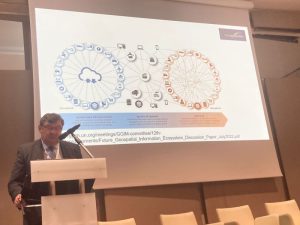OME2 successfully delivers harmonised cross-border data as 18,000 users download 15,500 datasets
More than 18,000 users have downloaded some 15,500 pan-European datasets and carried out 96.4 million web service transactions since Open Maps For Europe 2 (OME2) launched in early 2023.
The three-year project saw users of the Open Maps For Europe platform increase by 450% – from 4,000 to just over 22,000. In particular, the OME2 high-value large-scale prototype exceeded expectations, attracting 600 registered users – more than quadruple the initial target of 150.
Since its release in 2024, the 1:10,000 scale authoritative dataset, covering administrative boundaries, transport and hydrography across 10 countries, has generated nearly 5,000 WFS transactions. It is the first dataset created using the new production process, developed by OME2 Consortium member, National Institute of Geographic and Forest Information (IGN France), to deliver edge-matched official geospatial information from multiple national sources.
In addition to IGN France, the project partners comprise: EuroGeographics, the not-for-profit association for Europe’s National Mapping, Cadastral and Land Registration Authorities; National Geographic Institute, Belgium; Hellenic Cadastre; General Directorate for the Cadastre, Spain; and Cadastre, Land Registry and Mapping Agency, The Netherlands.
Angela Baker, Head of Operations and Data, EuroGeographics said: ““The consortium is delighted to report that the project has achieved all its objectives and significantly increased the number of users of pan-European data.”
“OME2 creates the foundation for a pan-European Spatial Data Infrastructure by solving the complex challenge of delivering usable sovereign data across Europe. This fulfils a long-standing EU requirement for streamlined access to an authoritative cross-border dataset without navigating multiple national portals or complex data integration.”
“The production process and technical specifications save users time, effort, and resources by providing harmonised data from multiple countries through a single portal with one easy-to-understand licence. This advances the data-sharing tools needed for free-flowing, interoperable data across the single market. It also supports the European Strategy for Data, as well as the Open Data and Public Sector Information Directive by enabling EuroGeographics members to apply OME2 techniques nationally and share best practices."
OME2 has delivered:
High-value large-scale pan European prototype
- 1: 10 000 scale authoritative administrative boundary, transport and hydrographic data for Austria, Belgium, Czech Republic, Denmark, Finland, France, Luxembourg, Spain, Switzerland and The Netherlands.
- Data in Geopackage download by theme, country or administrative area or WFS, WMS or WMTS via the Open Maps For Europe portal.
New production process and technical specification
- Underpinned by national expertise in integration of core geospatial data.
- Quality, edge-matching, harmonisation and generalisation tools
Enhanced existing datasets available via the Open Maps For Europe portal including:
Open Cadastral Map: the prototype map service for European cadastral data
- Includes all 15 planned countries with Basemap introduced to aid user experience.
- Delivery of a pan-European Cadastral Data Strategy.
OME2 ran from 2023 to the end of 2025. It was co-funded by the European Union with matched investment from EuroGeographics and its members.
EuroGeographics is an international not-for-profit organisation (AISBL/ IVZW under Belgian Law. BCE registration: 833 607 112) and the membership association for the European National Mapping, Cadastral and Land Registry Authorities.
The OME2 project was co-funded by the European Union. It was delivered by a consortium comprising: EuroGeographics, the not-for-profit membership association for Europe’s National Mapping, Cadastral and Land Registration Authorities; National Geographic Institute, Belgium; National Institute of Geographic and Forest Information, France; Hellenic Cadastre; General Directorate for the Cadastre, Spain; and Cadastre, Land Registry and Mapping Agency, The Netherlands.
Views and opinions expressed are those of the author only and do not necessarily reflect those of the European Union or European Commission. Neither the European Union nor the European Commission can be held responsible for them.


 EuroGeographics President, Tomaž Petek represented members at the European Association of Aerial Surveying Industries (EAASI) recent annual Partnership Summit in Croatia.
EuroGeographics President, Tomaž Petek represented members at the European Association of Aerial Surveying Industries (EAASI) recent annual Partnership Summit in Croatia. 
 Five new countries have been added to the final release of the Open Cadastral Map which has been enhanced by the Open Maps For Europe 2 (OME2) project.
Five new countries have been added to the final release of the Open Cadastral Map which has been enhanced by the Open Maps For Europe 2 (OME2) project.